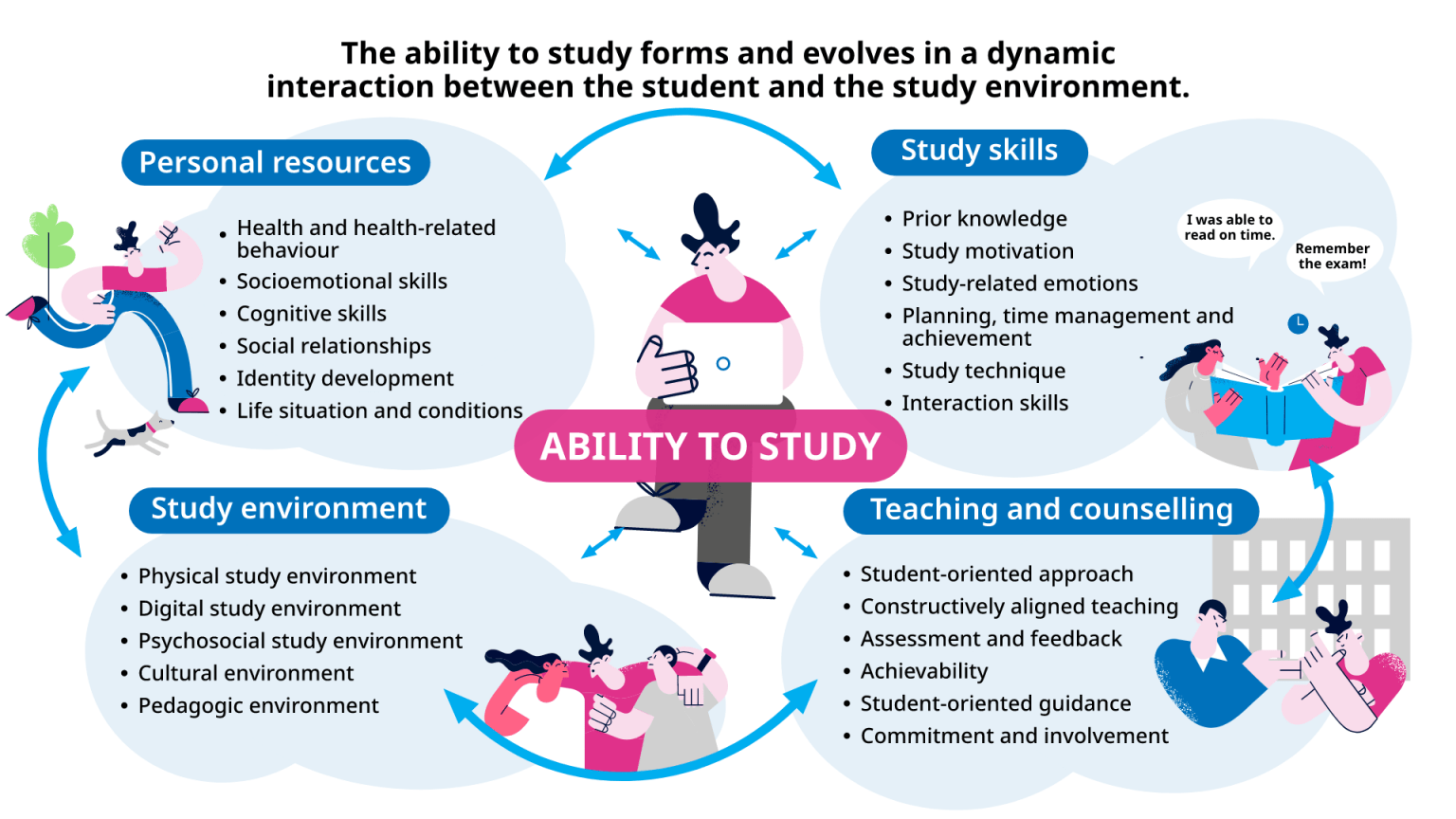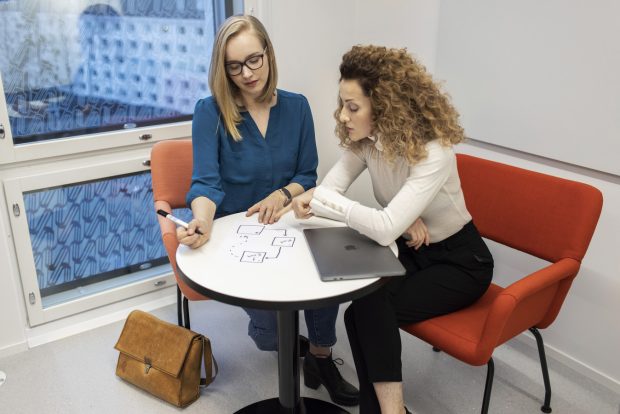A significant number of higher education students face difficulties during their university studies. Loneliness, isolation from social networks, lack of academic study skills and problems with study motivation have been found to have a detrimental effect on progress in studies (Klemola et al., 2020). Self-regulation and co-regulation skills have also been linked to study exhaustion in university studies (Räisänen, 2021). In addition, the COVID-19 pandemic, which lasted for almost three years, has contributed to a decrease in enthusiasm for learning and a strong increase in study burnout (Salmela-Aro & Uotinen 2022).
Especially first-year higher education students are at risk of burnout in the beginning of their studies, and have a strong need for study guidance (Hyytinen et al. 2022). Students in Metropolia University of Applied Sciences have also experienced study burnout. During the last academic year 2021–2022, 650 students contacted Metropolia Student Wellbeing Services, and on an average, had three meetings with a study psychologist, student wellbeing advisor or wellbeing coach. According to the reporting of the Student Wellbeing Services counselling professionals, approximately one in six of these students had worries related to exhaustion and fatigue, and one in five students had study stress listed as at least one of the reasons for seeking support from Student Wellbeing Services.
Due to the ongoing decrease in higher education students’ wellbeing we decided to address this challenge in Metropolia Student Wellbeing Services and develop a custom-oriented model for low-threshold counselling services.
Study ability and wellbeing in Metropolia Student Wellbeing Services
The ability to study refers to the student’s ability to work (Kunttu, 2021). Studying can be considered as the daily work of a full-time student with its own specific features. The concept is similar to work ability, which in turn, has been viewed through the relationship between work and the resources of the individual. Correspondingly, study ability is formed through the interaction of the student and factors related to studying.
The Finnish Institute of Occupational Health (FIOH) and the Finnish Student Health Service (FSHS) have developed a Study Ability Model which, in addition to the student’s own personal resources, consists of study skills, study environment and teaching and counselling activities (Figure 1). The model for ability to study was first created by Kristina Kunttu in FSHS and then the FIOH published it in a student health guide in 2006. The model for ability to study was based on the work ability model. (Kunttu, 2021.)

Figure 1. The model for ability to study (Finnish Student Health Service, 2023)
Metropolia’s Student Wellbeing Services utilize the FSHS’s model for ability to study as a counselling tool. The development of the Traffic Light Service Model (TLSM) has the same idea as the traffic light poster for coping at work published by Mieli ry (2022). Mieli ry’s traffic lights remind the work community to follow and listen to the sensations of their own body, follow the warning signs given by their thoughts, feelings and bodily symptoms, and, if necessary, stop and take a breath. Metropolia’s TLSM combines both of these models.
Shared, visual and simple model for counselling
In Metropolia’s TLSM for study wellbeing, three customer groups (the three different colors of the lights) provide a refined understanding of the so-called student-customer’s ability to study and study wellbeing. It is more appropriate to design and develop customized services for three different target groups than to look at all students as one customer group that, in reality, has different service needs and a variety of factors affecting their study ability and wellbeing experience.
The Student Wellbeing Services team in Metropolia supports students when they are concerned about issues related to their ability to study or study wellbeing. This includes topics such as:
- time management
- study skills
- motivation
- concentration problems
- difficult or unexpected life situations
- stress and exhaustion
- relationship worries
- minor concerns about mood or anxiety.
Finnish Student Health Service, one’s own communal health center or other healthcare providers respond to challenges concerning students’ mental health. If students would need more of therapeutic support, their ability to study has clearly decreased or they have long-term or recurring mental health issues, they are guided to contact health care providers instead of the Metropolia Student Wellbeing Team.
In Metropolia’s Student Wellbeing Services, student wellbeing advisors, study psychologists and a wellbeing coach support and guide students in challenges related to personal life, coping or studying. Over the past year, the Student Wellbeing Services’ team has been developing customer-oriented services, and as part of this created their own Traffic Light Service Model for student wellbeing. In the TLSM model, the key elements are
- students’ ability to study and their sense of wellbeing, and
- the green, yellow and red light services offered to support them (Figure 2).

Figure 2. Traffic light service model (TLSM)
Green light services are meant for students whose study ability and wellbeing experience are good. Studies are progressing in a goal-oriented manner (40–60 ECTS credits/academic year) and the wellbeing experience is also good (8–10/10 on a scale of 0–10, 10 being the highest value). The study ability and wellbeing experience are good and therefore guidance counselling provided by the degree program and other study support activities, e.g. tutoring, student associations and peer-support, are sufficient measures to promote the student’s higher education studies.
Yellow light services are for those students whose study ability and wellbeing experience have decreased. Their progress in studies has slowed down because of individual reasons (20–<40 ECTS/academic year) and/or the personal sense of wellbeing is only moderate (4–7/10 on a scale of 0–10). The students contact Student Wellbeing Services themselves or they are guided to use the service by staff members or student health care. Student wellbeing advisors, study psychologists and the wellbeing coach offer 1-5 individual counselling sessions aimed at restoring the study ability, promoting wellbeing and reconnecting with one’s studies. During and after the individual counselling process students can be guided to use both green and red light services.
Students whose studies are progressing poorly or have been interrupted (< 20 ects/academic year or less) and/or whose wellbeing experience is poor (0–3/10 on a scale of 0–10) are included in the scope of red light services. In red light services, students usually need frequent and stronger support from for example Finnish Student Health Service (FSHS), other social and health services or public or non-governmental organizations to regain their ability to study, improve their wellbeing and continue their studies. Depending on the individual situation, sometimes the short-term individual counselling process provided by Metropolia Student Wellbeing Services is enough to boost study ability and wellbeing, but often this kind of low-threshold counselling service can help relieve the student’s situation while waiting for access to FSHS or other social and health services.
Examining traffic light colours in counselling
Compared to regular traffic lights, in the Traffic Light Service Model the order of the lights is the opposite, as the green light is at the top and the red light is at the bottom. With the unusual arrangement of the lights, we want to emphasize the importance of preventive counselling work in higher education. The more preventive services are invested in and the students have good study ability and wellbeing, the less health care or rehabilitation services are needed later.
When developing the TLSM, it has been acknowledged that the student’s ability to study can be good and, at the same time, the wellbeing experience may be poor or, on the contrary, the ability to study may be weakened but still the wellbeing experience may be good at the same time.
The TLSM takes into consideration the pace in which the studies are progressing and the student’s personal experience of their wellbeing. The TLSM helps the employees of the Student Wellbeing Services design customer-oriented services for students who have similar concerns about their ability to study or study wellbeing.
The advantages of the Traffic Light Service Model outweigh the disadvantages by far
In Metropolia’s Student Wellbeing Services, two student wellbeing advisors, three study psychologists and a wellbeing coach tested the TLSM during counselling meetings in March 2023. At the end of the test period, the team made a summary identifying the following advantages and disadvantages regarding the use of the TLSM model during individual counselling processes.
Advantages of using the Traffic Light Service Model
- A visual tool in guidance and counselling helps the student and the counsellor to stay focused and keep the goals of the process actively in mind. It helps to recognize obstacles and steps forward in improving one’s study ability and wellbeing.
- The model provides the student with an opportunity to evaluate subjectively the study ability and wellbeing experience. Students can recognize the different factors affecting their wellbeing and notice that even though one area of their life could be in the red light area, other areas could be ok in green area.
- The model is a tool for observing and recognizing the change in study ability and wellbeing.
- “to paint a big picture”: how study ability and wellbeing have been before, how they is now, and how they could be in the future
- difficult phases in one’s study path are not just disturbing ruptures rather they become like a chapter or a theme in the big story of one’s university years
- helps to see the value of the process in improving one’s study ability and wellbeng
- The model helps in guiding students to utilize other services (e.g. study coordinator, student health services, social worker etc.). This way, it is easier for the student and the counsellor to decide which topics to work on during the short-term individual counselling process in the Student Wellbeing Services.
- It works for both the student and the counsellor as a way to build common understanding of the student’s life situation, study ability and wellbeing experience.
- TLSM is simple enough and easy to use in the beginning, during or the end of the counselling meeting. It can be used in different phases of the counselling process for initial evaluation and goal setting or for evaluating the change process.
Disadvantages of using the Traffic Light Service Model
- The model is not suitable during initial phases of crisis interventions, especially the first meeting. However, it would be usable in the end of the intervention when the focus has shifted to recovery and returning back to studies.
- TLSM does not provide information about students’ study ability and wellbeing on a general level. The color of the traffic light and the evaluation can change quickly during the counselling process.
University students seek individual counselling for study ability and wellbeing in many different situations. The TLSM helped to keep the focus of individual counselling meetings in the study context. The most prominent advantage was the simplicity and flexibility of the model as a visual counselling tool. As noted above, difficulties in one or several areas of life could make the wellbeing experience or study ability weak momentarily. The situation can still improve rather quickly even during short-term individual counselling provided by Student Wellbeing Services.
To sum up, not everyone in the red light area of the TLSM need further referrals to health care or other support services, and oftentimes students use these services simultaneously.
Would you like to be our Traffic Light Service Model development partner?
Concerns about study exhaustion and burnout of higher education students during their studies have grown over the past few years. For this reason, educational organizations should include elements that support mental health as a natural part of their structures, operating culture and educational content. It has been noted that the personnel of educational organizations should have stronger knowledge and competences to address mental health worries among university students.
At the same time, we should improve and ensure the accessibility of well-functioning student health care and low-threshold counselling in student wellbeing services and promote multidisciplinary cooperation between different professionals and service providers. This way, by preventing problems and identifying study exhaustion and burnout at an early stage, delays in studies could be reduced and the transition to further studies and working life accelerated. (Falck & Ärling 2020.)
Metropolia has responded to the above-mentioned development proposals for study ability and wellbeing by launching the development of the above-mentioned customer-oriented Traffic Light Service Model for study wellbeing. The development of the TLSM is a fairly new project in Metropolia Student Wellbeing Services. TLSM helps to create a shared framework for guidance personnel to promote student wellbeing and coordinate support services. The aim is to further develop the TLSM with the help of our students in order to strengthen positive study experience and wellbeing. At the same time, there is an opportunity to develop guidance and counselling services among the team’s employees and the communication about the services will also become easier with both customers and network partners through a shared and simple service model.
The Traffic Light Service Model described here is the first version (1.0), and the development of customer-oriented student wellbeing services is still in the start-up phase. Metropolia’s Student Wellbeing Services team welcomes feedback from students, staff members and networks for further development of the model.
Authors
Katri Luukka works as a wellbeing coach and a principal lecturer in Metropolia Student Wellbeing Services. As a wellbeing coach, Katri uses solution focused working methods in client work. Katri is interested in developing student wellbeing services through service design. Katri has a PhD degree in health science and a masters degree in health science education. She is also a solutions focused psychotherapist. Further information about the Traffic Light Service Model: .
Noora Mononen works as a study psychologist in Metropolia Student Wellbeing Services. Noora’s main areas of interest are individual counselling and developing international students’ wellbeing. Noora has a masters degree in psychology and education and has previously specialized in career counselling. Noora is currently in cognitive-analytical psychotherapy training.
References
- Falk, S. & Ärling, M. (2020). Voimaa opiskeluun – otetta ohjaukseen: Voimaa opiskeluun -hankkeen loppujulkaisu. Diakonia-ammattikorkeakoulu.
- Finnish student health service (2023). Ability to study. Retrived 30.3.2023.
- Hyytinen, H., Tuononen, T., Nevgi, A. & Toom, A. (2022). The first-year students’ motives for attending university studies and study-related burnout in relation to academic achievement. Learning and individual differences 97, 102165.
- Klemola, U., Ikäheimo, H. & Hämäläinen, T. (2020). OHO-opas – opiskelukykyä, hyvinvointia ja osallisuutta korkeakouluihin. OHO!-hanke.
- Kunttu, K. (2021). Opiskelukyky. Teoksessa Kunttu, K., Komulainen, A., Kosola, S., Seilo, N., Väyrynen, T., Aalto-Setälä, R. & Ripatti-Toledo, T. (toim.). Opiskeluterveys. 2., uudistettu painos. Helsinki: Kustannus Oy Duodecim. 37-53.
- MIELI ry (2022). Työssäjaksamisen liikennevalot. Retrieved 30.3.2023.
- Räisänen, M. (2021). The interaction between self- and co-regulation of learning and study-related exhaustion during university studies. Tiedepolitiikka 46(3), 35.
- Salmela-Aro, K. & Uotinen, S. (2022). The pandemic put university students’ study engagement to the test and greatly increased burnout. University of Helsinki. Retrieved 30.3.2023.









Ei kommentteja